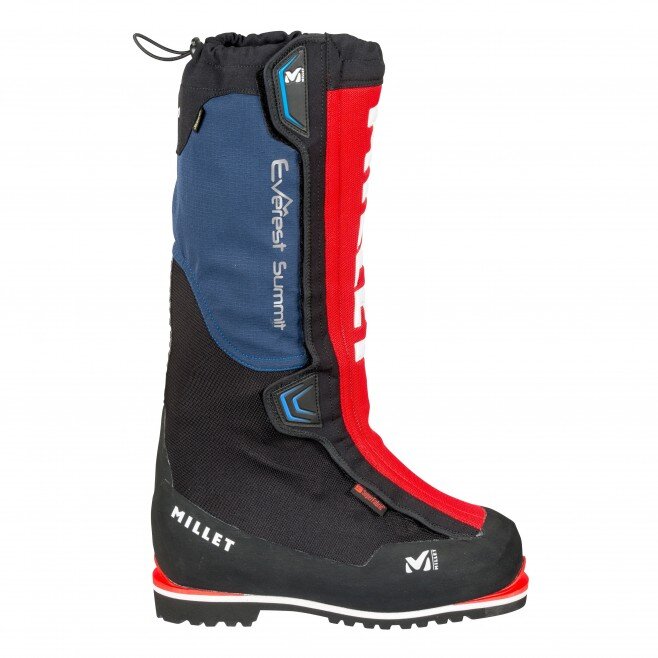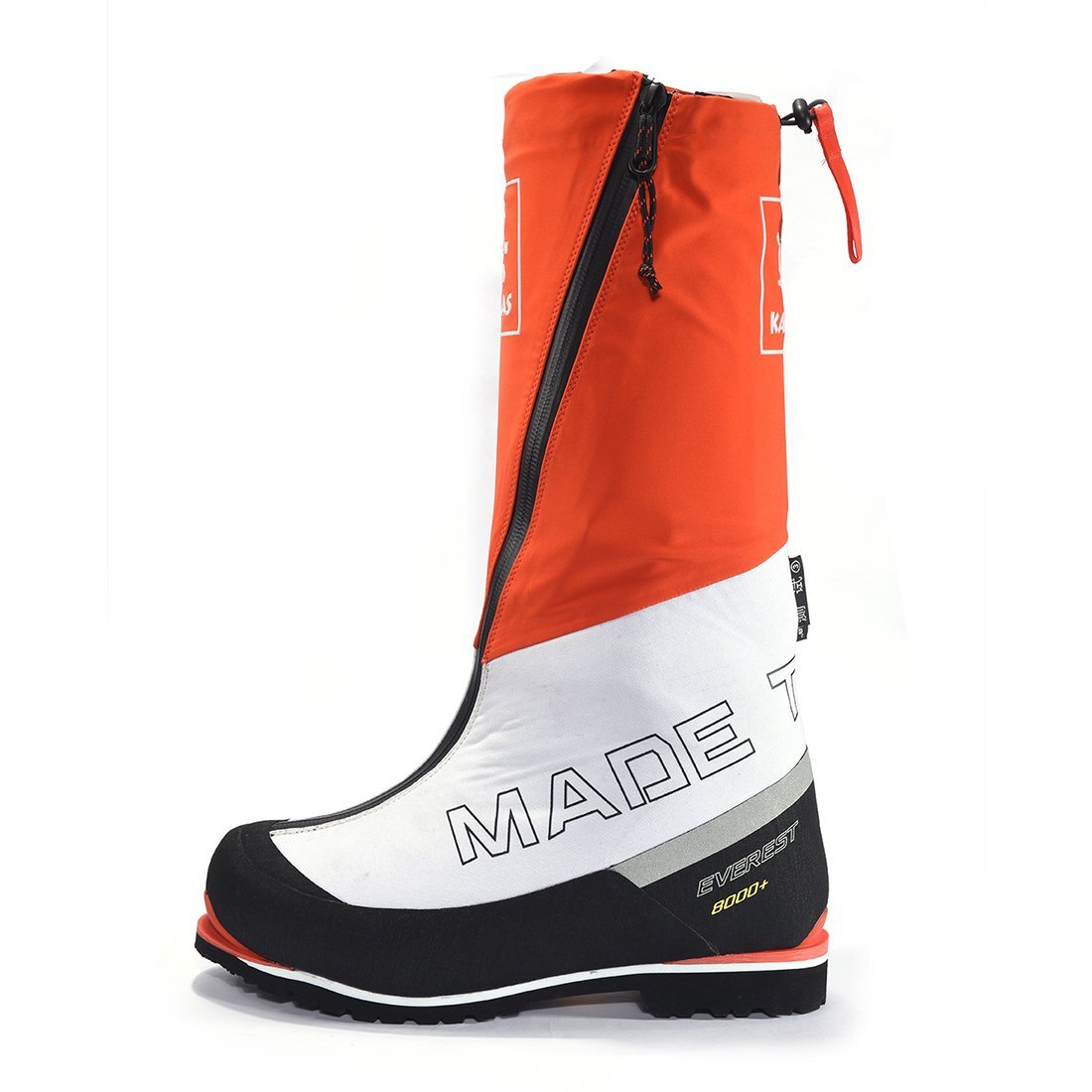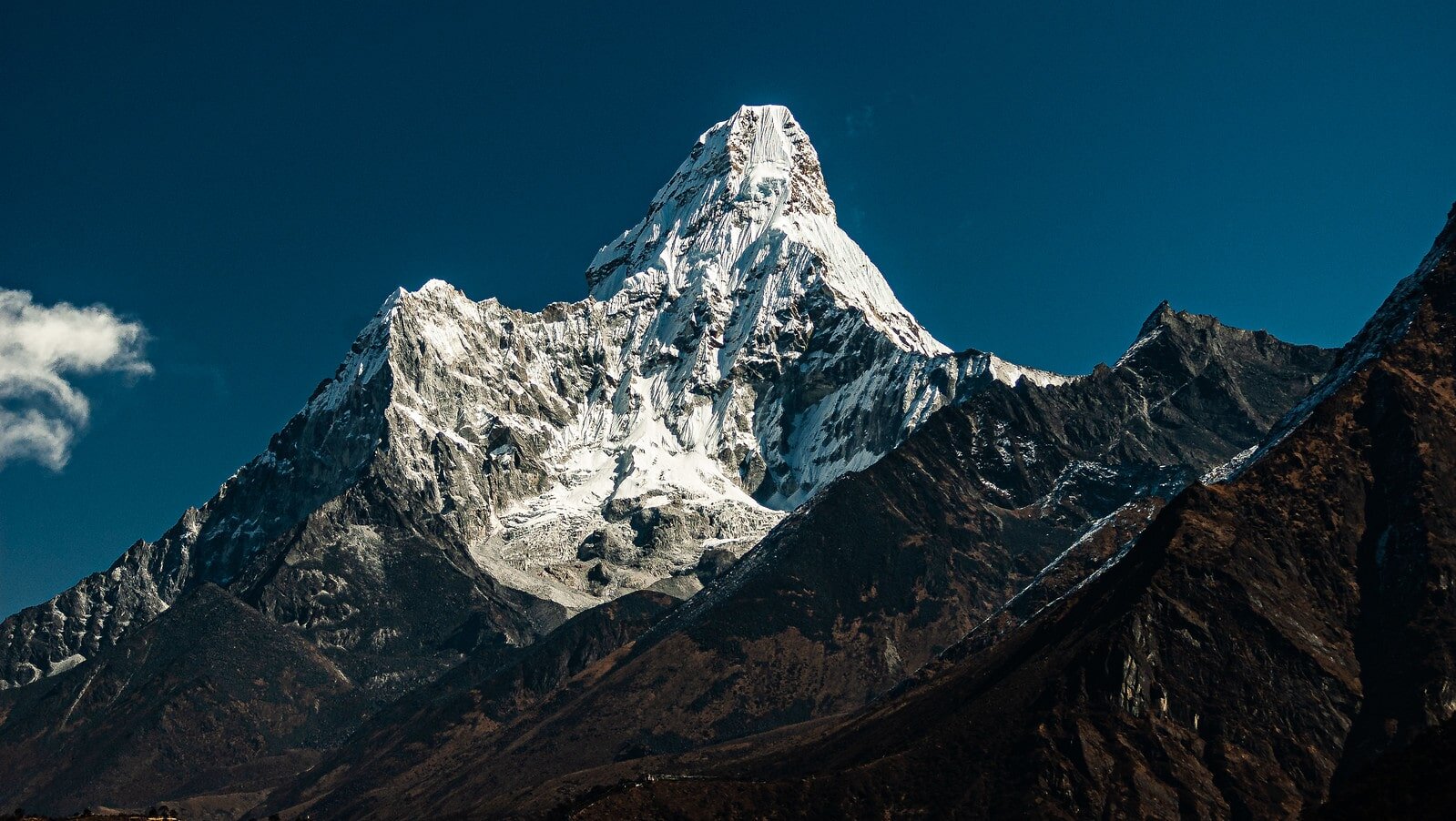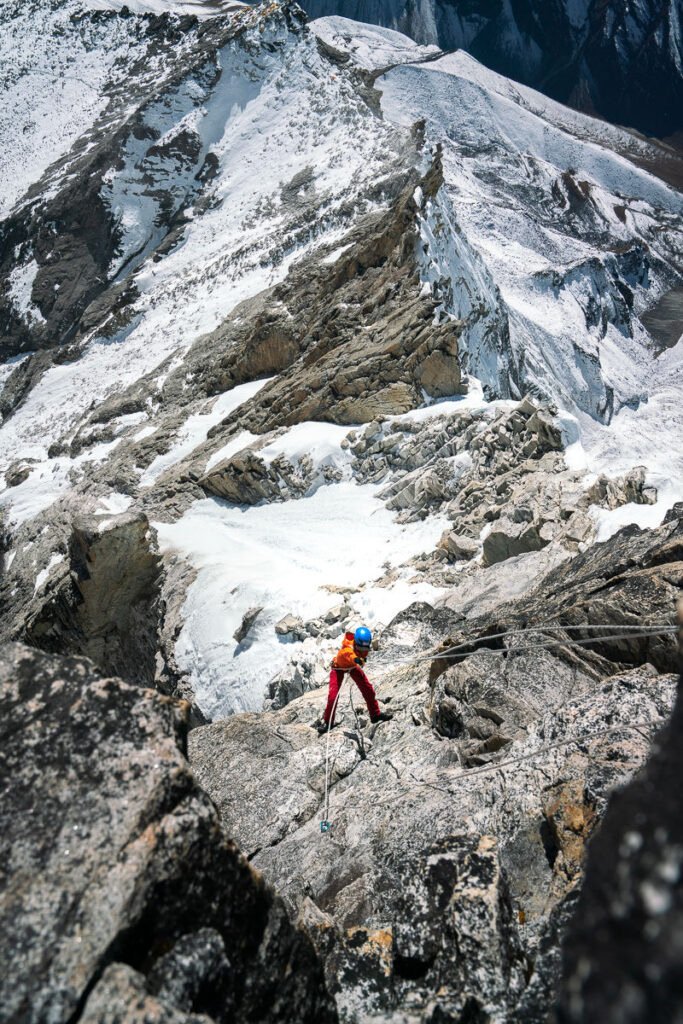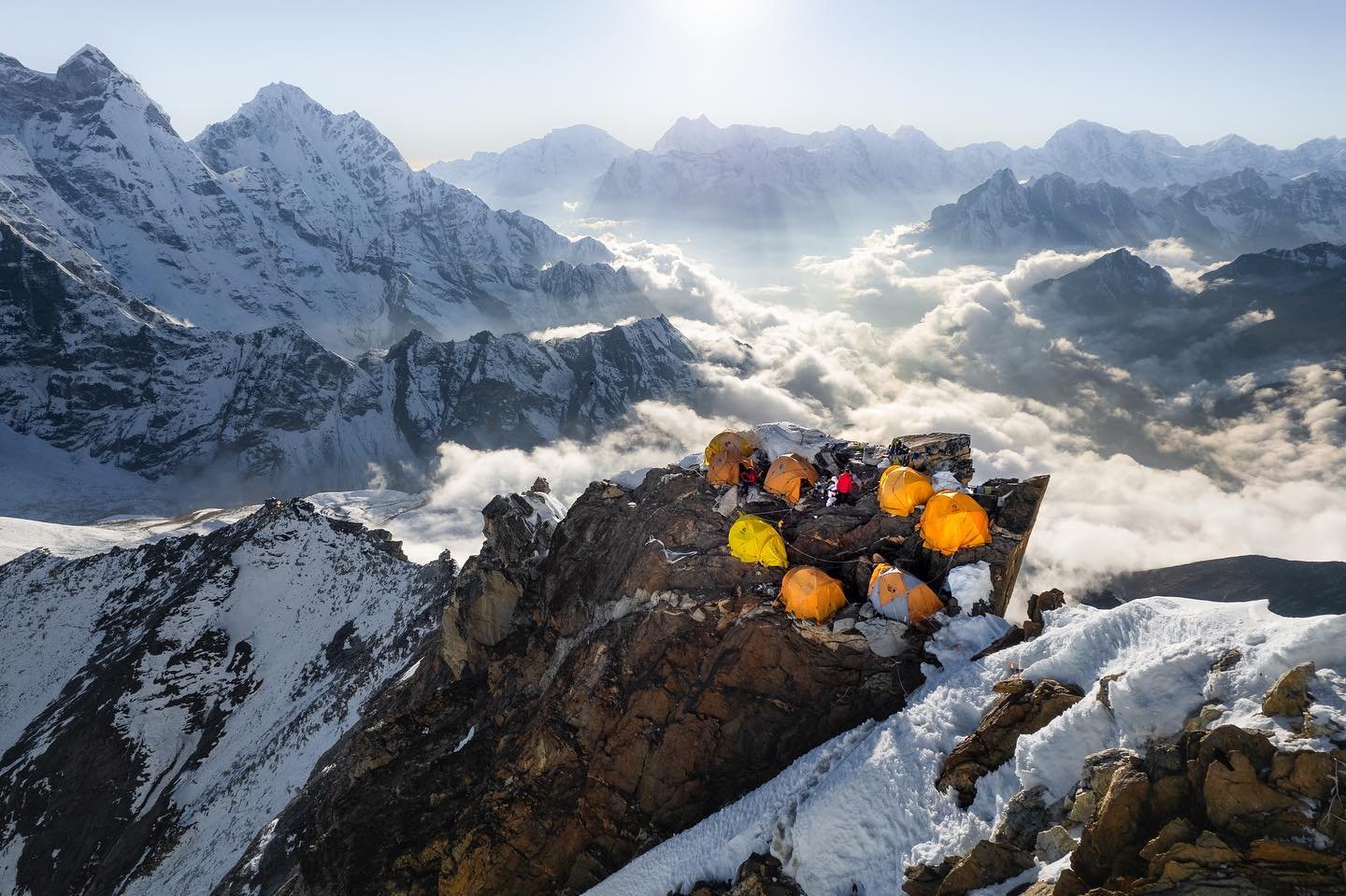When to climb Ama Dablam? (Spring or Autumn) - Namas Adventure
When planning an expedition to climb Ama Dablam in Nepal, you may be wondering what the best time to tackle this peak is. With years of experience leading expeditions and local knowledge from our guides, we can say that it really depends on your preference for climbing in different conditions. Luckily, Ama Dablam is accessible for climbing in both spring and autumn. In this article, we will outline the conditions you can expect during each season, so you can choose the one that best fits your style and preferences.
What’s the difference between Spring & Autumn climb? 🧗
There are fewer climbers during the spring season (70% fewer climbers) compared to the autumn season.
More snow/Ice on the mountain during the spring season result.
The spring season sees a longer daylight duration compared to the autumn season.
Spring climbing days are colder & more snow showers are to be expected.
Autumn sees more stable weather compared to the spring season.
More Avalanche prone (Camp 3) during Autumn.
Spring (Mid March - End May) sees a lot more snow compared to autumn. The spring season on Ama Dablam is a true test of adventure and endurance. With fewer crowds and the added challenge of fresh, deep snow, it's the perfect opportunity for thrill-seekers to test their mettle. The chance to stake a claim on the notorious Yellow Tower is a rare and coveted opportunity, and the chance to tackle the mountain's vertical and exposed sections with minimal traffic is an experience not to be missed. Spring tests your patience, especially when things don't go according to plan, and teams may need to improvise a lot. That's why spring sees fewer climbers on other peaks (excluding Everest and Lhotse) compared to autumn. However, when spring does offer clear weather, it is one of the best times to climb in Nepal.
Irina Galay - Ama Dablam Spring Expedition
Autumn (Mid-September - End of November) attracts many climbers to most of the peaks in Nepal. The snow and ice melt during spring and monsoon, revealing granite rock formations that are visible while climbing. The post-monsoon air brings clean and crisp conditions, and the snow in the Himalayan peaks has melted and settled significantly compared to the deep, snowy conditions of spring. This makes the climbing conditions more favorable for all climbers. The season starts earlier, with shorter days and stable weather conditions. The autumn season begins in September and typically sees snowfall towards the end of November, with heavy falls expected as winter approaches. Ama Dablam is particularly popular with climbers during this season, and is probably the most famous peak to climb in autumn."
Conclusion
As you stand at the base of Ama Dablam, the icy peak towering above you, you can't help but feel a surge of excitement and nerves. This is a mountain that demands respect, with its steep, technical routes and high altitudes. But you are ready for the challenge.
Whether you choose to brave the snowy conditions of spring or the crisp, stable autumn weather, one thing is certain: this will be an adventure you'll never forget. With fewer climbers on the mountain during the spring season, you may even have the chance to claim your own slice of solitude on the iconic Yellow Tower.
As you make your way up the mountain, the challenges will come thick and fast. From vertical ice walls to exposed traverses, Ama Dablam will test every ounce of your skill and determination. But as you stand on the summit, triumphant, you'll know that the reward was worth it.
So what are you waiting for? Grab your gear and join us on an unforgettable journey to the top of Ama Dablam. It may be tough, but the memories you'll make will last a lifetime
Lets, go summit Ama Dablam and other peaks around the world.
Go.
Live Your Story.
Question.
Which season do you plan to climb Ama Dablam & Island Peak (or Lobuche East(? Please comment below, we’d love to hear from you.
We organize Ama Dablam and Island Peak expedition (or Lobuche East via Gokyo) every year during spring and occasionally during autumn. Planning to climb Baruntse one day? Whatever your climbing goal is drop us an email. Our team will be glad to have you onboard and together we shall achieve the summit and enjoy the climbing experience. Our team is here to assist and make your climb in the Himalayas an enjoyable, accessible, and comfortable one.
2021 Best Mountaineering Boots 7000 - 8000M - Namas Adventure
Extreme high altitude mountaineering is a geared heavy activity. Specialised gears are a must and mountaineering boots specially fit in that category. Mountaineering boots should be considered as an investment, as these boots are not only meant for climbing but serve other crucial functions to keep your feet protected so that the climber's feet are warm, safe, and performing. Let’s talk about the best boots for 7000M - 8000M+ level. How many or which boots depend on your personal preference. i.e one pair of boots for 7000m and the other pair for 8000M+ or just one pair for all expeditions. First, let’s discuss the important functional features of the boots and the rest can come later. Below are 2021’s best extreme high altitude boots for 7000M- 8000M+ level. So if you are planning expeditions like Baruntse, Manaslu, Ama Dablam, Himlung Himal, or Mt. Everest these are the boots we highly recommend. First, let us help you be clear with the category of boot and crampons needed for this type of expedition.
Mountaineering boots and crampon category (More on Boots category blog post):
B3 Boots (7000M & 8000M+)
B3 boots are designed for extreme mountaineering. This category of boots has the stiffest soles and uppers available, providing lateral and medial support for front pointing, step-kicking, and traversing on steep terrain giving climbers a high level of traction for the most challenging conditions. This category includes high-altitude double boots as well as lighter technical climbing models. These boots allow both heels and toe welts to allow fitting of C2 - C3 crampons to take advantage of the easy step-in attachment system of heel clip and toe bar. B3 boots are the best when it comes to innovations and standards of high-altitude mountaineering boots.
Insulations
Double
As the name suggests double boots feature a structured outer boot combined with an insulating liner boot that can be removed. They are generally slightly heavier than single boots and are bulkier, but they do offer that extra level of warmth. They can also be easier to dry in more remote locations, but the inner booties can be worn while you are tucked inside your sleeping bags.
Triple
This is a hybrid mountaineering boot and is becoming increasingly popular amongst both the makers and climbers when it comes to extreme mountaineering. Perhaps more similar to a single boot with the addition of an integrated gaiter for extra warmth and snow protection, this also helps to keep them drier than a single boot. If they do become wet, you can’t dry them as easily as you can a double boot.
Lacing system
Standard lacing system
Like the name suggest standard lacing system are the same as in any boots. The only benefit of this to BOA system is, should it break or is damaged it is easily replaceable with other extra laces. Like any normal shoelaces.
Boa system
BOA systems are a handy and easy method to loosen or tighten your shoes. Simply rotate the screws to tighten or pop open and adjust your feet to loosen. The only downside of this system is that it is hard or impossible to repair when you are climbing in the mountains. We have a kind of love-hate relationship with this, very convenient on one end and if it breaks we have no way to repair it especially in the mountains.
Crampons category
C2
C2 crampons are referred to as mixed, hybrids, or semi-step crampons. These crampons are ideal for winter climbing and alpinism. The binding system of C2 crampons is compatible with B2 and B3 boots as they require a stiff sole and heel groove to lock onto. Traditionally C2 crampon usually has 10-12 points that include secondary spikes, that are semi-sharp.
C3
C3 crampons combine a metal toe bail with a plastic heel lever and as a result, they are referred to as ‘Step in’. The Step-in system requires very stiff boots with both a crampon heel and toe groove, because of this they are only compatible with B3 mountaineering boots. C3 crampons normally have 12-14 points that offer the best performance on steep icy slopes and technical mixed routes. Additionally, aggressive front points offer the best penetration on hard ice and on some models the front tips are replaceable. These are ideal for the hardest winter climbs and high-altitude ascents.
Famous ones:
La Sportiva - Olympus Mons Cube
When it comes to mountaineering and boots La Sportiva is one of the market leaders and they do make amazing mountaineering boots. Olympus Mons Cube is their latest non plus ultra of technicality for Himalayan mountaineering, arctic crossings, and uses in extremely cold conditions. The boot is 100% made in the Dolomites and guarantees lightweight, quick fit, safety, and water repellent for the mountaineer. The model features extremely contained external volumes, for a dual thermal high mountaineering boot and reduced weight compared to the previous version becoming the lightest model in its category.
Boot Features
Gaiter: Water repellent, stretch Cordura® + extremely high abrasion-resistant fabric with UltraSonic Welding technology and internal heat sealing + inner water repellent gusset
Inner Shell: High tenacity Nylon uppers + PE with different densities + thermo-reflective aluminum
Lacing: Double Boa® Fit System in the upper part and in the lower part of the shell for differentiated lacing
Removable double bootie: High cut outer layer: 6 mm PE + EVA Single Density with Flex Zone and double hook&loop closure - Low cut inner layer: 4 mm PE + EVA Single Density
Insole: Insulating carbon HoneyComb 3 mm + Gold Insulation Aerogel 3 mm by PrimaLoft®
Midsole: TPU 2 mm polyurethane with differentiated thickness at the toe and heel for attaching the crampon + front insert for tech skialp binding
Sole: Combination of Vibram® Litebase and Vibram® MorFlex® Expanded EVA for maximum lightweight, abrasion resistance and thermal insulation
Weight: 1.300 g (1/2 pair)
Sizes: 38 - 48 (+ 1/2) (49-50 on request)
Scarpa - Phantom 8000
Worn by Nims Dai and the Nepalese team who summited the first K2 Winter climb. So you can be certain that these boots are bound to perform in the extremes. The Phantom 8000 represents the very pinnacle of SCARPA design to create the warmest technical boot for use on the world’s highest and coldest mountains. Built around the expedition-proven double boot concept, the innovative Phantom 8000 uses state of the art construction materials for lightweight, waterproof, and warmth. The gaiter now had an offset waterproof zip to make the outer boot even easier to get on and off when wearing gloves. The inner shell is now even warmer as well as easier to operate. Wintherm technology creates a secondary layer of insulation under the gaiter. The Sock-fit XT tongue combined with the new fast lock lace system and fast strap closure make it even easier to get a close, precise fit, with no pressure points over the foot.
Boot Features
Crampon Rating C3
Inner Boot Altitude 8000
Insole Carbon Fiber + EVA + Aerogel®
Last Outer Boot- HAR8 Liner- RL
Sole Vibram 0 Gravity Lite
Upper PU-Tek + S-Tech + H-Dry®
Weight 2650g pair 42
Millet - Everest Summit GTX
Millets iconic EVEREST SUMMIT GTX is their benchmarking boot built for most extreme conditions. Recco tracking technology is integrated into their boots. Technically pre-eminent with its absolutely protective and thermal design. This boot project’s hand-made Italian quality has played a major role in the history of mountaineering. Designed for a universal fit, which convinces all feet. Yannick Graziani wore this model when scaling the south face of Annapurna: it protected him from the biting cold of this inhospitable wall and the irreversible effects of frostbite. This "five-season" product is designed for extreme winters and expeditions at very high altitudes. Guaranteeing protection down to -60°C, the EVEREST SUMMIT GTX is the boot most widely used for off-the-scale trips thanks to its ample interior, giving highly accessible fit. No need to have a slim foot to benefit from its excellent performance-to-precision ratio. A boot ready to step into any faraway adventure - but above all, the adventures you invent for it.
Boots Features
Fabric technologies: Aero therm, Gore tex, Primaloft, Recco, Vibram
thermal construction: outer boot + shell + inner boot, isothermal to -60°c precise fit,
crampon compatible rigid plantar support
waterproof gaiter, anti
perforation upper, zip closure with reflective velcro over flap
Armor edge fabric on medial to protect from crampon damage
strong insulated inner shell, easy
quick lacing
high thermal efficiency inner boot, insulated insole
lightweight, precise mountaineering outsole
Not so Famous brands
Asolo - Manaslu 8000 GV
Technical and high-altitude mountaineering and extreme use in cold environments. Developed in collaboration with the Asolo Test Team the model is engineered for extreme alpinism and low temperatures use guaranteeing maximum performances. This is Asolo’s triple-layer boots. The external gaiter guarantees resistance to abrasion and thermal insulation. Their zip closure system is meant for fast, waterproof, and precision when putting on thier boots.
Boot Features
OUTER GAITER: High tenacity stretch Cordura + neoprene + Schoeller Soft Shell + Pu rand
GAITER LINING: Gore-Tex Extended Comfort Footwear
SHELL: Cordura laminated with aluminum film + polyethylene 3 mm
SHELL LINING: Polyesthilene + polyester
INNER BOOT: Cordura laminated with aluminum film + polyethylene 3mm
INNER BOOT LINING: Primaloft 400 grams
LASTING BOARD: Carbon fiber
ANATOMIC FOOTBED: Manaslu Primaloft + no woven textile
SOLE: Vibram Betulla + toe reinforcement in full Vibram rubber; microporous midsole + Tpu crampon attachments
FIT: Man
WEIGHT: 1.250 (g) (1/2 pair size 8 UK)
SIZE: 7-12 UK
Boreal - G1 EXPE
G1 Expe is a triple layer boot consisting of an integrated outer gaiter, mid-layer ‘shell’, and a removable inner bootie. The outer gaiter has a soft and comfortable elasticated cuff with both zip and strap closures for failsafe reliability. The lower portion of the gaiter is insulated with encapsulated layers of triple Thinsulate™ and polyethylene and is reinforced with an extremely rip-resistant material in the high wear zones. A new synthetic rand material has been used which is lighter and warmer than rubber and won’t perish in the high U.V light conditions found at high altitude. The outer surface of the mid-layer boot is constructed entirely from lightweight synthetic textile and lined with a tough and waterproof/breathable Cordura reinforced laminate. Sandwiched between is a 6mm layer of EVA foam for excellent thermal insulation. Our new ‘Tanka’ lace closure system is simple, secure, and easy to manage while wearing gloves.
Boot Features
UPPERS: Composed of three layers: A fully integrated and highly insulated outer gaiter, mid-layer shell, and removable inner bootie
OUTER BOOT: Integrated outer gaiter is a waterproof and highly breathable material with a waterproof membrane and fully Thermo sealed seams. Reinforcement panels in extra durable and tear-resistant material. The lower portion of the gaiter insulated with Thinsulate and polyethylene layers. Premium quality waterproof TIZIP. Shell: One-piece lightweight Teramida with Lorica and neoprene. 6mm EVA foam insulation layer and Cordura waterproof breathable lining. 1.4mm neoprene insole for thermal insulation. Easy to use 'Tanka' lace closure system. Lightweight TPU rand for durability
INNER BOOT: Bootie made from very lightweight and extremely insulative triple layer laminate. A heat-reflective aluminum film is bonded to a durable polyurethane outer layer and insulative EVA foam on the internal side. Boreal Dry-Line® waterproof breathable lining with fully Thermo sealed seams. Triple Thinsulate® layers (no adhesives used) surround the foot guaranteeing maximum thermal protection with no cold spots. The sole of the bootie is covered with a durable textured TPU surface. Easy-adjust 'Tanka' and strap closure system with the adjustable fit around the instep area
MIDSOLE: Ultralight Boreal PBG-680 carbon composite midsole with lateral torsion control. Unique Thinsulate® lining for superior underfoot thermal insulation
SOLE: Vibram Betulla super lightweight and highly insulative outsole in special low-density EVA / rubber mix. Dual-density EVA and PU shock absorbing layers. Differential hardness TPU toe and heel pieces for automatic crampons
USAGE: Extremely cold conditions. High altitude mountaineering. 8000m peaks.
WEIGHT: 2610 grs./pair (size 7 UK)
Fitwell - GNARO 8000
The warmest and lightest boot of its kind made with the best materials currently available. Cordura® fabric with ceramic paste coat to capture UV rays and heating the hull. Gaiter lined and coupled with waterproof Event® membrane for water and wind resistance. Oblique polyurethane coated zipper, watertight closure, easy opening and closing with gloves. Rubber rand 1.6mm thickness, anti-wear and anti-scratch. Hull structure: inside Cordura® coupled with EVA and aluminum film with Velcro closure for the highest foot comfort. Multi-layer lightweight, thermal liner, aluminum lined, absorbent felt and thermal wadding. Anti-slip insole. Carbon insole coupled with a nanotech insole reaching the highest standards of lightness and insulation.
Boot Details:
UPPER: Cordura® + Superfabric®
GAITER LINING: Waterproof eVent® fabric
INNER SHELL: Cordura® + felt + alluminium
INNER BOOT: Primaloft® + felt + aluminum
INSOLE: Carbon alveolar + Aerogel®
SOLE: Vibram® Mulaz Evo + EVA
CRAMPON: Automatic C2 or C3
More details
Kailas - Everest Boots 8000M
Boot details:
Extremely wear-resistant and durable - Outer shell made of Dyneema® mesh, YKK Waterproof zip, puncture-resistant fabric and efoam mudguard Supremely warm and comfort - Inner boot made of PE insulation and thermo-reflective aluminum film and Graphene insulation that keeps you warm at -60℃dynamically. PrimaLoft® Gold Insulation Aerogel at forefoot and toes can withstand a low temperature of -78℃.
Boot Features
Single/Double: Double
Weight: 1300g (size 42)
Gaiter: Wear-resistant Dyneema® mesh / efoam mudguard / puncture-resistant fabric / YKK Waterproof zip/ 3M reflective graphic
Outer boot: Bulletproof laces / QFS(Quick Fitting System)
Inner boot: Graphene insulation / PE insulation / Thermo-reflective aluminum film / Extremely durable TPU
Insole: 3 layers: anti-bacterial and anti-odor foam, non-woven polyester and thermo-reflective aluminum film PrimaLoft® Gold Insulation Aerogel at forefoot and toes
Midsole: Lightweight and high-strength carbon fiber lasting board
Outsole: Vibram® ultralight outsole for alpine climbing. Completely crampon compatible.
Lacing system: Velcro closure, YKK zip, bulletproof laces
More details
Conclusion
Choose the best one that’s out there in the market. With companies innovating and developing high-performing boots out there it is much safer for climbers now more than ever. We have listed some of the most famous ones to lesser-known brands which are still amazing boots. We cannot stress this enough but quality (highest) matters. You do not want to lose your toes or suffer from any frostbite incidents. The game is extreme in the Himalayan altitudes.
Which mountaineering boots do you prefer and why did you choose that particular boot? Please comment below :)
Go. Take on your peak.
Live Your Story
10 important things to know about Ama Dablam climbing Expedition - Namas Adventure
Ama Dablam 6810M
Ama Dablam is known for its stunning beauty and is a highly sought-after mountain for mountaineering enthusiasts. It is considered a challenging climb on its own and is often viewed as a "must-do" for those who are interested in alpinism and mountaineering. Many people choose to tackle Ama Dablam either before or after attempting a larger expedition like climbing Mount Everest.
History: Ama Dablam was first summited on 13th March 1961, a Silver hut scientific expedition led by Sir Edmund Hillary. Ama Dablam's expedition has been a dream for many mountaineers. Its Southwest ridgeline is the safest route to climb this amazing peak.
We have listed 10 useful pieces of information that will help you prepare for your Ama Dablam peak climbing expedition.
1. When is the best time to climb Ama Dablam?
Ama Dablam is best suited to climb during three climbing seasons.
Spring (Mid-April-May) - There are hardly any climbers during the spring season solely because major expedition companies are focused on the Everest expedition. Climbers seeking fewer teams and climbers on the route are recommended to climb during spring.
and Autumn (September - November) - Autumn attracts a lot of climbers. You can expect a lot of teams climbing from Mid October - November end. November - December is less busy but a tad colder compared to peak October expedition.
Early Winter (December - January) - Winter climbs are for the extra gritty challenge seekers. This is another best time of the year when there are very few climbers and the Everest trails are quieter. Winter officially begins on 21st December. As expected be ready to brace for crispy cold and an unexpected gust of wind.
Note - Ama Dablam is the 3rd most sought technical climbing peak in the Khumbu region, with the majority of the permits being issued during the autumn season.
2. Climbing route and difficult sections, mountain grading of Ama Dablam climbing
All major commercial expeditions use the Southwest Ridge section route of the mountain. Ama Dablam expedition is graded at TD / 5 in difficulty. (Alpine / Fitness grading link).
Exposed section after Camp 2.
This expedition involves steep vertical mixed climbing on rock, ice, and snow. You must be in excellent physical and mental condition to tackle this challenging climb. Do not underestimate the difficulty of this mountain. Your previous climbing experience will help you gauge your fitness level and understand how to safely tackle the climb. With proper preparation and guidance from our team, you can achieve your dream of climbing Ama Dablam. The sheer vertical ascent of this mountain will likely be one of the toughest climbs you have ever attempted. However, the breathtaking beauty and exhilarating experience of reaching the summit make it all worth it. Are you ready to push yourself physically and mentally to reach the summit of Ama Dablam? It will surely be one of the most memorable peaks you ever climb."
Notable technical Sections at Ama Dablam climb.
Note - Your entire climb from camp 1 to the summit will be assisted by a fixed rope.
Climbing to Camp 2 “Yellow Tower”
Images by Jackson Groves / Journey Era
The route from Camp 1 to Camp 2 is one of the most technically challenging parts of the expedition. The climb to the top of Yellow tower involves a 90-degree vertical ascent. This section of the route is graded anywhere from 4.11 to 5.7 - 5.10 in rock climbing terms. It's important to consider the impact of altitude, carrying a backpack, cold weather, and ice conditions on the mountain while attempting this climb.
Mushroom Ridge 6250M (Between Camp 2 and Camp 3)
This section of the route is not for the faint-hearted, as you will need to carefully climb up and scramble on the steep rocky face of the mountain before reaching an exposed knife-edge ridge. Walk carefully across the ridge, which has 600-meter drops on both sides, before continuing your climb towards Camp 3.
3. How much does Ama Dablam expedition cost and what does it include?
The cost of the Ama Dablam and Island Peak expedition with Namas Adventure (Please click here for cost). Our team provides premium, all-inclusive services, including 1:1 climbing support, local guides who share their knowledge of culture and traditions, and a focus on safety, successful summit strategy, and top-quality base camp support. Our team is dedicated to being a responsible, ethical, and sustainable mountain adventure operator, so climbers can fully enjoy their climbing experience.
List of what’s included in your booking.
IFMGA/NMA certified Guide leader
Namas Branded merchandise (Down Jacket, Cap, Buff)
1:1 Sherpa Guide /client ratio.
Head chef and assistants ( Helpers increase with the number in climbing team members )
Arrival hotel in Kathmandu
All trekking and climbing permits (Khumbu Region Permit and TIMS)
All internal-local transportation to and from the trekking trailhead
Expedition tents (2 or 1 person tents) Brands Salewa, Mountain Hardwear, Samaya equipment, Kailas
30 kgs personal weight
Chocolate, energy bars, hydration pills, biscuits, canned foods, nuts
Burners and expedition equipment
Walkie-talkie/ Satellite phone/GPS
Breakfast, Lunch, and Dinner on trek and expedition days.
Lodge accommodation during the trek
Porters per guest
The arrival pick up and departure
Basic First aid kit
Welcome/Farewell leave Dinner
4. Are guides necessary for Ama Dablam Peak?
Climbing Ama Dablam requires a permit, which can only be obtained through a registered local company in Nepal. It is mandatory by Nepalese law to have a guide on high altitude peaks above 6,000 meters. We recommend hiring a guide for climbers of all levels, as a successful expedition requires a strong team with a proficient base camp crew and experienced, competent, and trustworthy climbing Sherpa guides.
5. Choosing the best-acclimated itinerary for climbing Ama Dablam
Proper acclimatization is crucial for success on any high-altitude climbing expedition. Our team follows the "climb high, sleep low" mantra and will conduct rotations to Camp 1 and 2 as part of our acclimatization strategy. Through our years of experience, we have carefully crafted the itinerary to ensure the best possible chance of success for your expedition.
6. How difficult is it to climb Ama Dablam? What training and skills are required?
Ama Dablam, also known as the "mountaineer's mountain," is a challenging climb that requires experience and determination to reach the summit. The route from the base camp to Camp 1 (5800 meters) involves climbing moraines and a rocky boulder uphill. The fixed line normally starts after Camp 1, where the climb becomes more technical. The climb to Camp 2, located on top of the Yellow Tower, is the first crux of the climb, requiring a 60-70 foot vertical granite ascent at 20,000 feet. The mushroom ridge from Camp 2 to Camp 3 is another challenge, and Camp 3 is only set up once the guide leader determines it is safe. From Camp 3, climbers head up the pyramid to the summit, which involves an exposed climb on 55-65 degree slopes. The descent is difficult, especially on tired legs, and requires careful focus.
Training for Ama Dablam
To prepare for this challenging climb, it is important to focus on endurance, core, and strength training. This will help you to handle the vertical sections of the ascent, such as the "Yellow Tower" on the way to Camp 2. Suggested training activities include long-distance running, cycling, and hiking with added weight. It is recommended to begin training at least 12 weeks in advance of your climbing departure. More on our training mountain expedition blog.
Skills
Additionally, taking advanced mountaineering classes can be helpful in learning technical skills like rope climbing and proper use of gear. For the Ama Dablam climb, it is recommended to be comfortable with multi-pitch climbs up to a grade of 5.10 a,b,c and to have experience with mixed climbing. Ice climbing skills up to WI-3 or WI-4 are recommended for spring climbs, although fixed-line ropes will be used for the steeper sections of the mountain.
You should be proficient with the above-mentioned mountaineering skills, climbing with ice axe support and abseiling independently in exposed mountain terrain. Be ready for a long descent when coming down from the summit. This is particularly where most of the incidents occur during this expedition. A few accidents did occur on this route when the climber did not properly attach the safety rope to the main fixed line when abseiling down the mountain.
Ama Dablam's climbing should not be taken lightly. By no means is the peak an easy climb and we require interested climbers to have a previous high altitude of several 4000M+ to 6000M+ technical climbing experience anywhere in the world. You have to be in your best physical fitness shape. All mountain expeditions are graded based on their technical and physical difficulties. Successfully accomplishing the Ama Dablam expedition is a mixture of teams, skills, the right experiences, fitness, mental strength, weather, and other detailed mountain-climbing factors.
7. Right clothing, gear, and boots (trekking and mountaineering)? Rental options for Ama Dablam climbing?
Choosing the right gear is very important. We advise climbers not to make compromises on the quality of gear and clothing, and to pay attention to layer up comfortably as well. You will depend highly on your clothes to keep you warm enough for the dropping temperatures at nighttime which can go down to -10c /-20c. Please check our equipment blog for recommended clothing and gear.
Renting your gear in Nepal? The simple answer is NO. This is one of the most frequently asked questions mainly by beginner climbers. We have tested and tried several gears in Nepal and frankly, we do not recommend hiring here. We know it might seem like a huge amount of expense to buy all the gear, but they are well worth it. You can even hire from the city you live in. Make sure they are original products from well-known adventure gear companies. (North face, Mountain hardware, Kailas, etc.)
Boots (trekking and mountaineering) for Ama Dablam climb
With better technologies, climbing shoes have improved every year. We highly recommend double-layered boots like Kailas Everest 8000M, La Sportiva Olympus Mons Cube, Scarpa 8000 phantom, and Millet Everest summit GTX. It is wise to spend on good mountaineering boots, as so with all the gears that we have mentioned in this post above.
More 8000M boots link here (other media article)
8. Hydration and nutrition
To ensure proper hydration, we recommend that all clients drink 4-6 liters of water per day. It is helpful to bring hydration tablets or filtration bottles. Obtaining water at higher camps can be difficult, so our team will do their best to boil snow and provide water at higher camps and during the summit push. Most meals are prepared in tea houses, and during climbing days, our Sherpa team sets up kitchen tents. While it can be difficult to eat enough in cold, high altitudes, it is important to try to force yourself to eat. We also provide packed dried meals as an alternative option.
It is important to avoid smoking and alcohol consumption during the Ama Dablam expedition. While it may be common to see the guiding leaders engage in these activities, they are professionals who have adapted well to high altitude environments. As a climber on this adventure holiday, it is important to prioritize your health and well-being by abstaining from these harmful habits. Remember to also pay attention to your diet and hydration, as these will greatly affect your performance on the mountain.
9. Insurance and Helicopter evacuation for Ama Dablam Expedition
No matter how prepared you are, you never know when or how things might go wrong. You might be sick suddenly or not that we wish but there might be some incident, you might suffer from altitude sickness or anything we can’t imagine yet. So, for these reasons, it is always good to have insurance coverage. Our recommended Insurance companies (link)
Helicopter evacuation is our final emergency option and we do recommend you have one in your insurance, as it is the only means of transport in the Everest region. Our guides will assess your condition and examine if it is a major issue. If not, they will use their experience to motivate and push you through your trip. However, in case of emergency, helicopter evacuation will be called upon.
There is a procedure to follow when calling for emergency evacuation. We will call the insurance company hotline, get approval from your insurance, and only then helicopters are sent to the distress call location. You will have to pay for the evacuation in Nepal from your own pocket but once you are back home you can claim your money back. Make sure you collect helicopter evacuation receipts, a certified doctor’s approval letter. The insurance company will ask for this evidence to back up your claim. There was a huge helicopter scam in Nepal in 2018, so insurance companies are taking extra measures to stop this from happening. Our guides and staff members in Kathmandu will also remind you of this process during briefings.
10. Next climbing goals after Ama Dablam climbing
It is only natural that as a climber, you would want to climb higher, more challenging peaks. Once you have successfully completed Ama Dablam, consider yourself one of the capable mountaineers. Climbers know that summiting Ama Dablam is no easy feat, so you should be able to take on even higher peaks, such as those over 8,000 meters, after this climb.
Mt. Everest Expedition 8848M
Manaslu Expedition
Annapurna IV 7525M
k2 8611m Expedition
A successful Ama Dablam climbs with a strong yet fun environment expedition team, proper training, and planning before the expedition is possible. These are the things that are within your control. As we have stressed enough Ama Dablam climb is not an easy one and you will have to get every aspect right so that you have a better chance of completing your expeditions and have a great time. Join our fun-loving yet providing the best service and safety team on our yearly Ama Dablam Expedition. Our team would love to have you on board and make your dream of climbing Ama Dablam a success.
Ama Dablam Expedition - Click here
If you do have any more questions, please ask us below in the comment section or you can email us at bookings@namasadventure.com and our team will get back to you as soon as they can. Stay well.
Challenge yourself. Dare great things and live your story.









